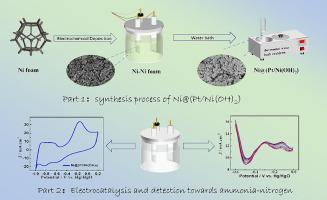当前位置:
X-MOL 学术
›
Microchem. J.
›
论文详情
Our official English website, www.x-mol.net, welcomes your
feedback! (Note: you will need to create a separate account there.)
Achieving Ni@(Pt/Ni(OH)2) ternary nanoflowers derived from Ni nanoflowers for electrochemical ammonia–nitrogen detection in the aqueous environment
Microchemical Journal ( IF 4.9 ) Pub Date : 2024-03-23 , DOI: 10.1016/j.microc.2024.110401
Liang Zhang , Xiying Ma , Jialu Liu , Jiali Gu , Hui Suo , Chun Zhao , Xinyue Wang
Microchemical Journal ( IF 4.9 ) Pub Date : 2024-03-23 , DOI: 10.1016/j.microc.2024.110401
Liang Zhang , Xiying Ma , Jialu Liu , Jiali Gu , Hui Suo , Chun Zhao , Xinyue Wang

|
In this work, Ni nanoflowers were electrodeposited on the Ni foam surface. And then, ternary Ni@(Pt/Ni(OH)2 ) nanoflowers were fabricated on the surface of Ni nanoflowers based on the sample and facile galvanic replacement reaction between Ni nanoflowers and H2 PtCl6 ·6H2 O. The electrocatalytic activities of all synthetic Ni@(Pt/Ni(OH)2 ) toward ammonia oxidation reaction have been measured via cyclic voltammetry (CV). As the potential sensing electrode, the abilities of ammonia–nitrogen detection have been evaluated via CV and differential pulse voltammetry (DPV) under optimum conditions of prepared Ni@(Pt/Ni(OH)2 ) nanoflowers. The limit of detection is 0.82 μM with high sensitivity of 0.075 mA µM−1 cm−2 . The measured results indicated that the fabricated sensor has good anti-interference ability, reproducibility and stability in ammonia–nitrogen determination. This obtained Ni@(Pt/Ni(OH)2 ) sensor exhibited good recovery in detecting ammonia–nitrogen in real samples including lake water from 97.59 % to 100.61 % and sea water from 93.86 % to 97.31 %, indicating a great potential application for the detection of ammonia–nitrogen in water.
中文翻译:

实现源自 Ni 纳米花的 Ni@(Pt/Ni(OH)2) 三元纳米花,用于水环境中的电化学氨氮检测
在这项工作中,Ni 纳米花被电沉积在 Ni 泡沫表面上。然后,基于样品和 Ni 纳米花与 H2PtCl6·6H2O 之间的简单电置换反应,在 Ni 纳米花表面制备了三元 Ni@(Pt/Ni(OH)2) 纳米花。所有合成Ni@ (Pt/Ni(OH)2) 对氨氧化反应的电催化活性均已通过循环伏安法 (CV) 测量。作为电位传感电极,在制备的 Ni@(Pt/Ni(OH)2) 纳米花的最佳条件下,通过 CV 和差分脉冲伏安法 (DPV) 评估了氨氮检测的能力。检测限为 0.82 μM,高灵敏度为 0.075 mA μM-1 cm-2。实测结果表明,所制备的传感器在氨氮测定中具有良好的抗干扰能力、重现性和稳定性。获得的 Ni@(Pt/Ni(OH)2) 传感器在检测实际样品中的氨氮方面表现出良好的回收率,包括湖水从 97.59% 到 100.61%,海水从 93.86% 到 97.31%,表明在水中氨氮检测方面具有很大的潜在应用。
更新日期:2024-03-23
中文翻译:

实现源自 Ni 纳米花的 Ni@(Pt/Ni(OH)2) 三元纳米花,用于水环境中的电化学氨氮检测
在这项工作中,Ni 纳米花被电沉积在 Ni 泡沫表面上。然后,基于样品和 Ni 纳米花与 H2PtCl6·6H2O 之间的简单电置换反应,在 Ni 纳米花表面制备了三元 Ni@(Pt/Ni(OH)2) 纳米花。所有合成Ni@ (Pt/Ni(OH)2) 对氨氧化反应的电催化活性均已通过循环伏安法 (CV) 测量。作为电位传感电极,在制备的 Ni@(Pt/Ni(OH)2) 纳米花的最佳条件下,通过 CV 和差分脉冲伏安法 (DPV) 评估了氨氮检测的能力。检测限为 0.82 μM,高灵敏度为 0.075 mA μM-1 cm-2。实测结果表明,所制备的传感器在氨氮测定中具有良好的抗干扰能力、重现性和稳定性。获得的 Ni@(Pt/Ni(OH)2) 传感器在检测实际样品中的氨氮方面表现出良好的回收率,包括湖水从 97.59% 到 100.61%,海水从 93.86% 到 97.31%,表明在水中氨氮检测方面具有很大的潜在应用。

































 京公网安备 11010802027423号
京公网安备 11010802027423号